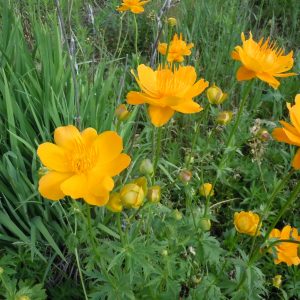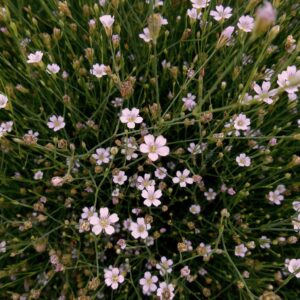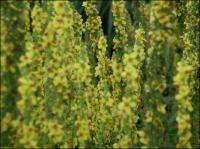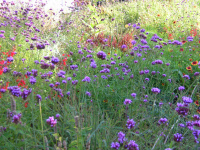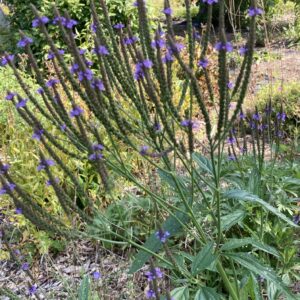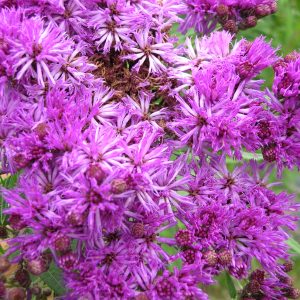Perennials & Biennials
Showing 489–496 of 511 results
-
Trollius europaeus Globe flower Z 5-8
Ball-shaped deep golden buds opening to nearly orange cups with prominent stamens from May to June & sporadically in September
Ball-shaped deep golden buds opening to nearly orange cups with prominent stamens from May to June & sporadically in September
Size: 18-24”x 24”
Care: Full sun to part shade in moist to wet soil
Native: Northern EuropeTrollius is derived from the old Swiss-German word trol meaning “something round,” referring to the shape of the flower. Swedish used the fragrant drying flower petals for a strewing herb. Introduced to European gardens by the 1500’s and cultivated in America in the 1700’s. Grown in the Eichstätt Garden, the garden of Johann Konrad von Gemmingen, prince bishop of Eichstätt in Bavaria, c. 1600.
Grown by Jefferson.
-
Tunica saxifraga syn. Petrorhagia saxifraga Tunic flower Z 4-8
Free blooming pixie, palest of pink blossoms from June through October on wiry stems form a 4" tall mound.
Free blooming pixie, palest of pink blossoms from June through October on wiry stems form a 4″ tall mound.
Size: 6" x 8"
Care: Full sun in well-drained soil.
Native: Pyrenees and Alps
Wildlife Value: Drought tolerant.
Awards: Royan Horticultural Society Award of Merit.
Size: Perfect for rock gardens, front of borders or groundcover.Tunica is Latin meaning tunic or coat referring to overlapping bracts beneath the flower. Before 1753. Near the turn of the century William Robinson described the Tunic flower as having “elegant little rosy flowers … a neat plant for the rock garden and fringes of borders and thrives like a weed between the stones in a rough stone wall.” “Suggestive of a miniature gypsophila.” H.H. Thomas, 1915.
-
Vaccinium macrocarpon syn. Oxycoccus macrocarpus Cranberry Z 3-7 Evergreen shrub
Clusters of nodding clusters of pink tube-shaped flowers in spring grow into large cranberries in September-October.
OUT OF STOCK
Clusters of nodding clusters of pink tube-shaped flowers in spring grow into large cranberries in September-October.
Size: 8-10" x 2-3'
Care: sun in moist well-drained acidic soil
Native: Northern east coast to northern central US & Canada, Wisconsin native
Wildlife Value: attracts bees, butterflies, and birds for nectar; small animals eat the fruits and nest in it“An easy to grow and beautiful ornamental …will thrive in moist soil. A bog is not necessary… The evergreen plants make dense 8” to 10” high mats of tiny leaves (that) bear little pinkish flowers in late spring, and in the fall the leaves turn as fiery red as the berries.” 25 sq ‘+ 5 lbs berries. Cuttings easily root. Plant 1 per sq. ft. Described by Aiton. Algonquin, Chippewa, Iroquois, Ojibwa ate the berries.
-
Vaccinium vitis-idaea Lingonberry, Mountain cranberry, Cowberry, Foxberry Z 2-7
Evergreen foliage on this shrub, In spring down facing, pink urn-shaped flowers bloom. Then in late summer bright red berries appear and persist into winter. Spreads to form colony.
OUT OF STOCK
Evergreen foliage on this shrub, In spring down facing, pink urn-shaped flowers bloom. Then in late summer bright red berries appear and persist into winter. Spreads to form colony.
Size: 6-12” x 3’ spreading
Care: sun to part shade in moist, very acidic soil
Native: Boreal forest and Arctic tundra in Northern Hemisphere from Eurasia to North America, Wisconsin native.
Size: Often made into jam, juice, syrup and relish. The berries contain high amounts of vitamin C, A and B1, B2, B3, as well as phytochemicals and omega-3 fatty acids. Historically used in folk medicine as an astringent, antihemorrhagic, anti-debilitive, depurative, antiseptic, diuretic, tonic for the nervous system, as well as treatment for breast cancer, diabetes, rheumatism, infections, gastrointestinal tract, kidneys, urinary tract ailments and fever.In 1745 Russian Empress Elizabeth ordered lingonberry planted all over grounds at Peterhof Palace in St. Petersburg. The common name Lingonberry comes from the Norse word for heather, lyngr. Vitis- idaea comes from vitis which is Latin for vine and idaea meaning “from Mount Ida.” According to L.H. Bailey, “Throughout the whole of N. Canada, hunters and trappers, as well as the native Indians, frequently depend on it for food. It is valuable for the shrubbery border, where the strong contrast of the dark green foliage and the bright colored persistent fruit is very striking.”
-
Verbascum nigrum Dark mullein Z 4-9
June to October (if deadheaded) canary yellow, occasionally ivory, spikes with purple stamens.
June to October (if deadheaded) canary yellow, occasionally ivory, spikes with purple stamens.
Size: 36" x 24"
Care: Sun in moist well-drained to well-drained soil - self-seeder. Drought tolerant.
Native: Europe to SiberiaVerbascum was named by the Roman Pliny who said they attracted moths, calling them Moth mulleins. Cultivated in gardens as long ago as Medieval times. Favorite plant in Elizabethan cottage gardens in the 1500’s. Grown in the Eichstätt Garden, the garden of Johann Konrad von Gemmingen, prince bishop of Eichstätt in Bavaria, c. 1600. Described by Parkinson in 1629 as: “a stalke whereon stand many golden flowers with the like purple threads in the middle.”
-
Verbena bonariensis Perennial Z 7-10, colder zones-reseeding annual
Small purple flowers atop tall leafless stems from July to October. Great see-through blooms for growing in back, middle or front of the garden.
Small purple flowers atop tall leafless stems from July to October. Great see-through blooms for growing in back, middle or front of the garden.
Size: 3-4’ x 8”
Care: full sun in moist, well-drained, fertile soil - self-seeder
Native: South America
Awards: Royal Horticultural Society Award of Merit & Missouri Botanic Garden Plant of Merit.Introduced to garden cultivation from its native Buenos Aires in 1726 by the Sherard brothers.
-
Verbena hastata Blue vervain, Simpler’s joy Z 3-9
Bright purplish-blue candelabra-like spikes from July to September
Bright purplish-blue candelabra-like spikes from July to September
Size: 2-4’ x 2’
Care: sun to part shade in moist or moist well-drained soil
Native: eastern 2/3rds of No. America, Wisconsin native
Wildlife Value: Cardinals & Sparrows eat the seeds. Food for larvae of Buckeye butterfly.Native Americans used plant as remedy for coughs, colds and fever. Mahuna Indians of So. California used the root to cure complicated stomach fevers. Sioux fed the seeds to their horses to give them energy. The Sioux also used it as an insect repellant. Pressed specimen in Emily Dickinson’s herbarium.
-
Vernonia fasciculata Prairie Ironweed Z 3-7
Dense clusters of true royal purple July-September
OUT OF STOCK
Dense clusters of true royal purple July-September
Size: 3-4’ x 2-3’
Care: sun to part shade in moist to moist well drained soil
Native: so central Canada to central & eastern US
Wildlife Value: Butterfly attractor – Fiery skipper, deer & rabbit resistant.Lakota Sioux: “The leaves are formed into a sort of “plate” that keeps foreign matter from getting on meat. An infusion of the root is used to regulate menstrual periods.”
Collected by French planthunter André Michaux (1746-1802) who spent 11 years exploring America for plants. Named to honor Wm. Vernon (1666-1711) English botanist who collected plants in late 1600’s.

